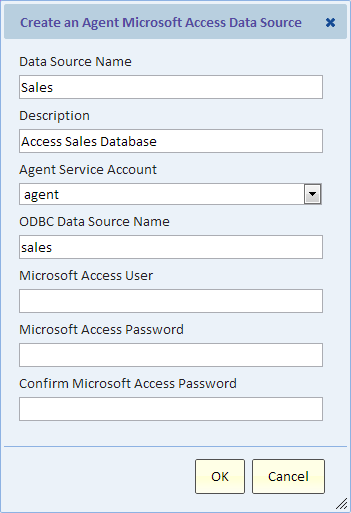Configuring a Microsoft Access Data Source
Contents
Overview
Before you can add a Microsoft Access data source, you must install the Explore Analytics Agent. Please see the section Installing the Explore Analytics Agent for installation instructions.
The agent should be installed on a Windows computer that has access to the database, typically the computer where the Microsoft Access database is installed.
The rest of this page assumes that you have the agent installed and running. You're now ready to setup a Microsoft Access data source and create live reports that draw data directly from your database.
ODBC
The Explore Analytics Agent uses ODBC to connect to your Microsoft Access data source. If an ODBC data source is not already defined for your Access database, you'll need to define it using the ODBC administration tools.
Creating the Data Source
To create the data source, go to the "Data" menu and select the option "Add a MS Access data source". You will see the following dialog (we show it with some example inputs already populated). We then explain each entry.
Data Source Name
Give this data source a name to identify it.
Description
Optional description. This is shown when you list data sources to help users choose the correct data source.
Agent Service Account
The choices for this field are typically pre-populated for you, and there's usually only one choice. This is the name of the Explore Analytics account through which the agent connects to Explore Analytics. You will need to make a selection here only if you have multiple agents that service different data sources.
ODBC Data Source Name
This is the host name (computer name) of the computer on which SQL Server resides. If the agent is installed on the same computer as the database, then you can typically refer to the host as "localhost" as in our example. If the database is on another computer, enter the name or IP address of that computer.
Microsoft SQL Server User
This is the name of the database user through which we connect to the database to access data. You can leave this field blank, to use "Integrated Security". That's a feature of SQL Server that identify the user based on their Windows user. Therefore, this would identify the database user to be the Windows account under which the agent is running (e.g., the local "administrator" account).
Microsoft SQL Server Password
The password of the user entered in the previous field. If you're using Integrated Security, then leave this field blank as well.
Microsoft SQL Server Database Name
Your SQL Server manages several "databases" each one has a database name (this is SQL Server terminology). The data source is for one such database. Please specify the name of the database (in our example it "northwind", the SQL Server example database).
Getting Help
Setting up an agent-based data source is the most difficult task in Explore Analytics. Don't hesitate to seek help. You can contact Explore Analytics Support.
